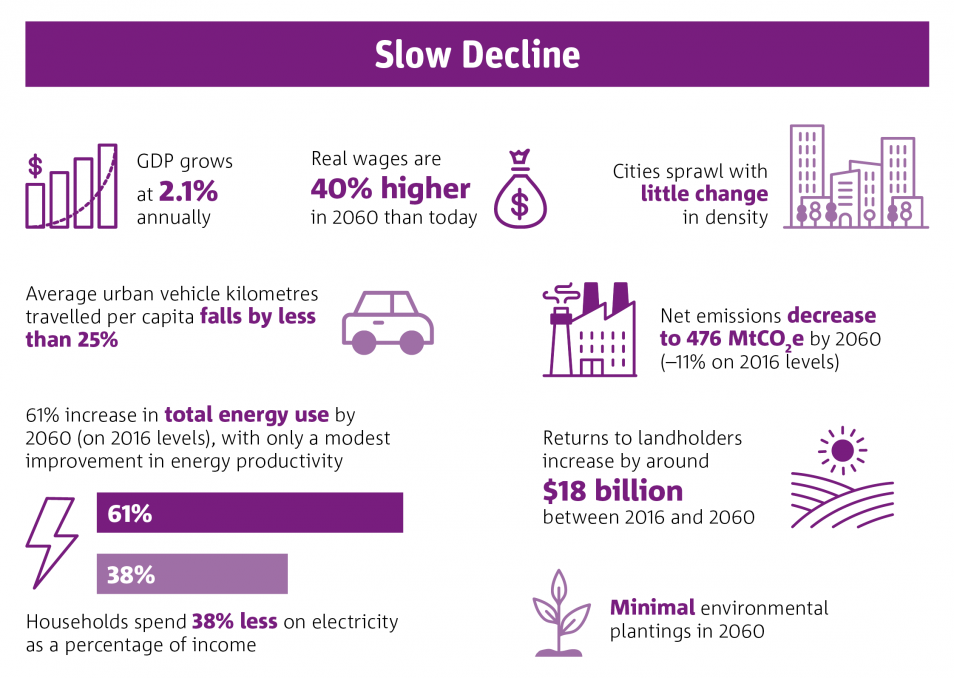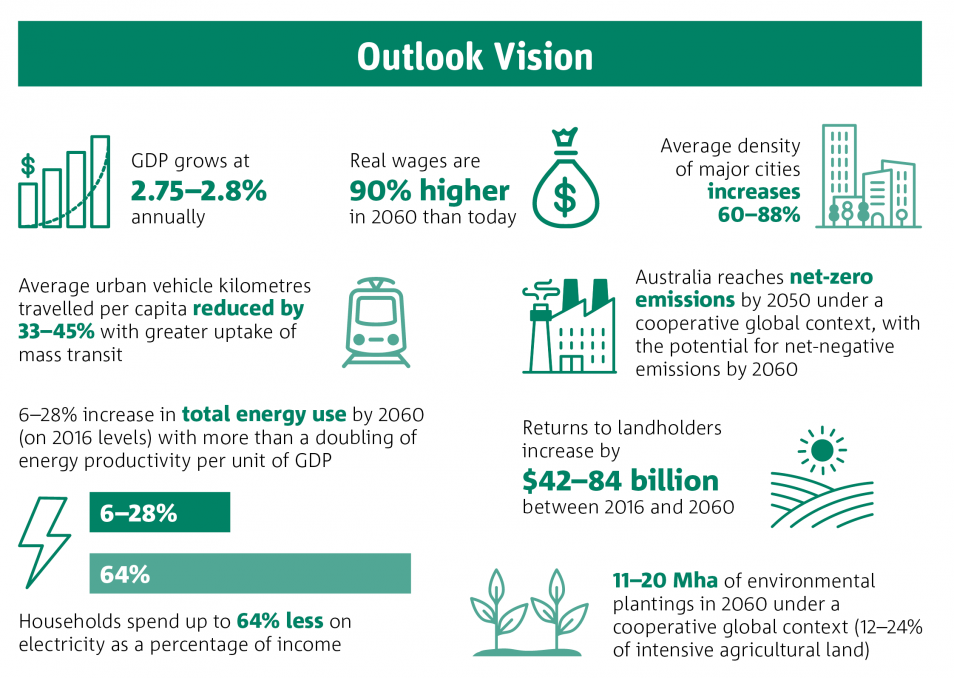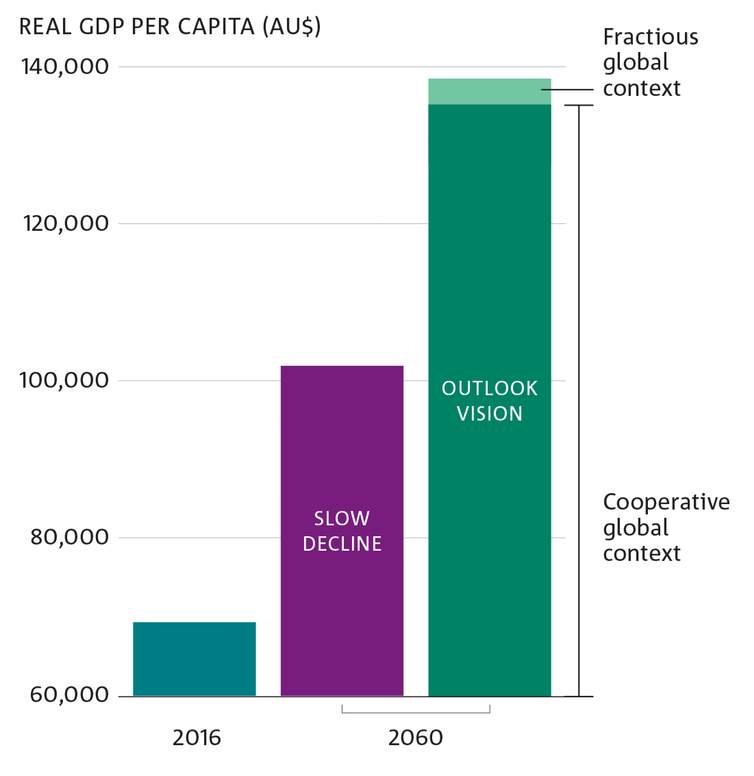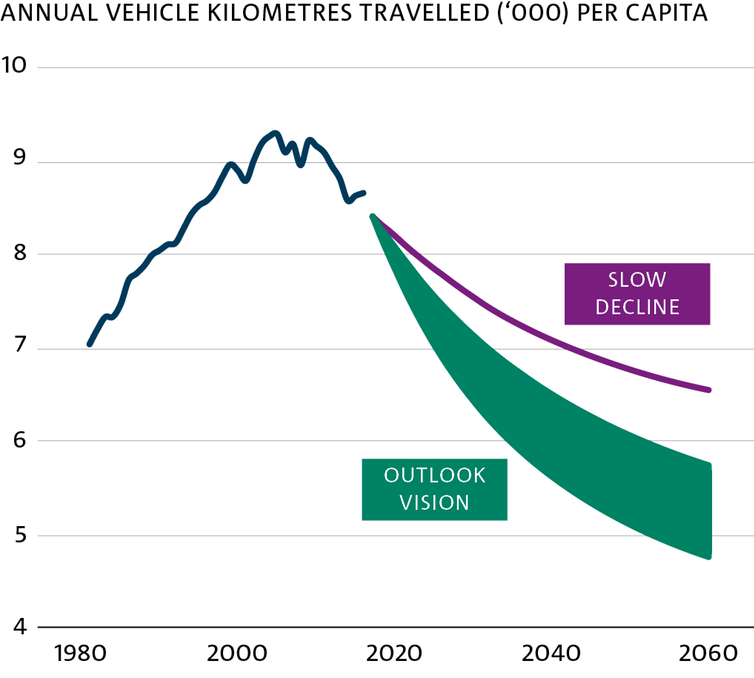
This article was first published in The Conversation.
Australia’s future prosperity is at risk unless we take bold action and commit to long-term thinking. This is the key message contained in the Australian National Outlook 2019 (ANO 2019), a report that we published today with our partners.
Our new research used a scenario approach to model different visions of Australia in 2060.
We contrasted two core scenarios: a base case called Slow Decline, and an Outlook Vision scenario which represents what Australia could achieve. These scenarios took account of 13 different national issues, as well as two global contexts relating to trade and action on climate change.
We found there are profound differences in long-term outcomes between these two scenarios.
Slow decline versus a new outlook
Australia’s living standards – as measured by Gross Domestic Product (GDP) per capita – could be 36% higher in 2060 in the Outlook Vision, compared with Slow Decline. This translates into a 90% increase in average wages (in real terms, adjusted for inflation) from today.

In the Slow Decline scenario, Australia fails to adequately address identified challenges. Image: CSIRO

The Outlook Vision scenario shows what could be possible if Australia meets identified challenges. Image: CSIRO
Australia could maintain its world-class, highly liveable cities, while increasing its population to 41 million people by 2060. Urban congestion could be reduced, with per capita passenger vehicle travel 45% lower than today in the Outlook Vision.

Australia’s real GDP per capita in 2016, and the modelled outcomes for Slow Decline and Outlook Vision. In Outlook Vision, the darker shade shows outcomes under a cooperative global context and the lighter shade under a fractious global context. Image: CSIRO
Australia could achieve net-zero emissions by 2050 while reducing household spend on electricity (relative to incomes) by up to 64%. Importantly, our modelling shows this could be achieved without significant impact on economic growth.
Low-emissions, low-cost energy could even become a source of comparative advantage for Australia, opening up new export opportunities.
And inflation-adjusted returns to rural landholders in Australia could triple to 2060, with the land sector contribution to GDP increasing from around 2% today to over 5%.
At the same time, ecosystems could be restored through more biodiverse plantings and land management.

Historical trend for vehicle kms travelled (VKT) on urban roads, per capita, and projections resulting from the modelled Slow Decline and Outlook Vision scenarios. The shaded area for Outlook Vision represents the range of outcomes possible depending on how regional satellites cities develop. Image: CSIRO
The report, developed over the last two years, explores what Australia must do to secure a future with prosperous and globally competitive industries, inclusive and enabling communities, and sustainable natural endowments, all underpinned by strong public and civic institutions.
ANO 2019 uses our integrated modelling framework to project economic, environmental and social outcomes to 2060 across multiple scenarios.
The outlook also features input from more than 50 senior leaders drawn from Australia’s leading companies, universities and not-for-profits.
So how do we get there?
Achieving the outcomes in the Outlook Vision won’t be easy.
Australia will need to address the major challenges it faces, including the rise of Asia, technology disruption, climate change, changing demographics, and declining social cohesion. This will require long-term thinking and bold action across five major “shifts”:
- industry shift
- urban shift
- energy shift
- land shift
- culture shift.
The report outlines the major actions that will underpin each of these shifts.
For example, the industry shift would see Australian firms adopt new technologies (such as automation and artificial intelligence) to boost productivity, which accounts for a little over half of the difference in living standards between the Outlook Vision and Slow Decline.
Developing human capital (through education and training) and investment in high-growth, export-facing industries (such as healthcare and advanced manufacturing) each account for around 20% of the difference between the two scenarios.
The urban shift would see Australia increase the density of its major cities by between 60-88%, while spreading this density across a wider cross-section of the urban landscape (such as multiple centres).
Combining this density with a greater diversity of housing types and land uses will allow more people to live closer to high-quality jobs, education, and services.
Enhancing transport infrastructure to support multi-centric cities, more active transport, and autonomous vehicles will alleviate congestion and enable the “30-minute city”.
In the energy shift, across every scenario modelled, the electricity sector transitions to nearly 100% renewable generation by 2050, driven by market forces and declining electricity generation and storage costs.
Likewise, electric vehicles are on pace to hit price-parity with petrol ones by the mid-2020s and could account for 80% of passenger vehicles by 2060.
In addition, Australia could triple its energy productivity by 2060, meaning it would use only 6% more energy than today, despite the population growing by over 60% and GDP more than tripling.

Primary energy use in Australia under the modelled scenarios. Primary energy is the measure of energy before it has been converted or transformed, and includes electricity plus combustion of fuels in industry, commercial, residential and transport. Image: CSIRO
The land shift would require boosting agricultural productivity (through a combination of plant genomics and digital agriculture) and changing how we use our land.
By 2060, up to 30 million hectares – or roughly half of Australia’s marginal land within more intensively farmed areas – could be profitably transitioned to carbon plantings, which would increase returns to landholders and offset emissions from other sectors.
As much as 700 millions of tonnes of CO₂ equivalent could be offset in 2060, which would allow Australia to become a net exporter of carbon credits.
A culture shift
The last, and perhaps most important shift, is the cultural shift.
Trust in government and industry has eroded in recent years, and Australia hasn’t escaped this trend. If these institutions, which have served Australia so well in its past, cannot regain the public’s trust, it will be difficult to achieve the long-term actions that underpin the other four shifts.
Unfortunately, there is no silver bullet here.


28th June 2019 at 3:45 pm
2060 I reckon on current trends half the population of 41 million will be in Melbourne and Sydney, which will pretty much suck the life and money out of the rest of the country as is already happening to country Victoria. By 2060 with the melting of the icecaps and more irregular monsoons, there are going to be lot of very hungry people to the North of us. On a per head basis every Australian uses more energy than anyone else in the world currently and then there is the energy we export coal and iron ore. The people to the North of us want living standards similar to us and who are we to denigh them? They will be still using coal stations in 40 years because they are still building them today.
We may or will have to consider ramping up farming where there is water, because from the above we could have a population in 40 years in excess of 50 million and perhaps towards 60 million. We need to start seriously investing in infrastructure outside the cities, because by the time we have ques for bread the knowledge will be lost. After all it was rural money/exports that gave the Victorian government nearly 10 billion dollars from the sale of the Port of Melbourne to invest in Melbourne, we were promised 10 percent, where has it gone. We should have had half. I know very political but all the scenarios proposed are the results of political decisions.
Water and the lack of it will be the most major issue for the majority of the worlds population and how to feed it.
The other major issue is the lack of a rural voice, there are a lot of platitudes and crumbs thrown of the table. Anything else is living in cloud cookoo land.
28th June 2019 at 2:34 pm
What the rest of the world does should be regarded as irrelevant. Someone always has to be the first to do something and to lead the way. Australia should be proud to do so. A low emissions, environmentally sustainable future is a must.
One of my main concerns is carrying capacity (max population sustainable without significant environmental impact) because, as far as I am aware, and despite Australia’s “wide open spaces”, the upper range carrying capacity for Australia is only 32 million based upon available natural resources . So a population increase to 41 million means, for example, not enough fresh water which requires the use of desal plants or similar to offset. And that requires a lot of capital investment that governments seem reluctant to do or taxpayers to pay for.
18th June 2019 at 5:25 pm
It would be nice to think that we could do the outlook vision scenario. A lot depends on our future actions. It is nice to have a road map to give a reality to the vision as many find it hard to see the way clearly.
18th June 2019 at 2:14 pm
I would like to see the large city high rise buildings be relocated to the inland country areas with residential high rise occupants have as partoftheir purchase access to suitable developed holiday apartments 4 weeks of the year in coastal holiday areas, If they don’t require them they can opt to have them rented out similar to short stay apartments . If you look at the maths a 120 appartment block in the country would only need a capacity for 10 holiday apartments these could be located any where I in the country, This type of development would be both benifical to the community and the environment urban sprawl can’t go on forever
R Wragg
18th June 2019 at 11:51 am
Who pays the farmers to store carbon on their farms via plantations? How does Australia going carbon free increase our wealth and GDP beyond what we would achieve with the continued use of fossil fuels where they offer economic advantages? This 2060 scenario seems to have blind faith in the rest of the world paying for carbon credits and going low- or no-carbon. If history is any guide, I have my doubts if such optimism is justified.